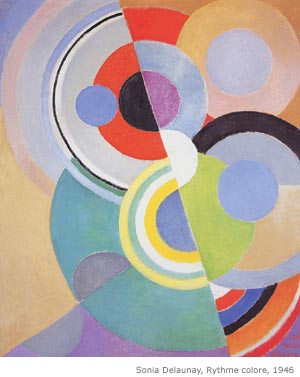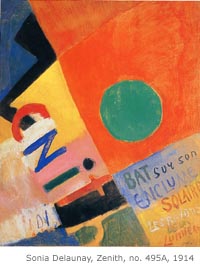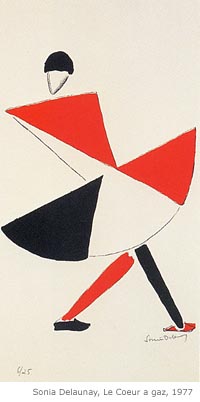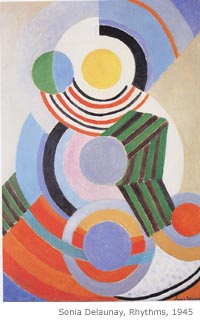
Sonia Delaunay danced with color.
She was an artist who used color to create rhythms, movement and emotion
in her work. You can hear music in Delaunays paintings. Like good jazz
drumming, they vibrate with an interplay of complex rhythms.
A pioneering figure in early modernism, Sonia Delaunay (1885-1979) forged
new paths in abstract painting and design. An exhibition of her work at
the Teien Art Museum brings together a range of her artistic endeavors
from a career spanning over 70 years.
Delaunay was born Sarah Stern in 1885. Her father worked in a factory
in Gradizhsk, in the Ukraine. At age five she was adopted by her wealthy
lawyer uncle and moved to St Petersburg. She was given the new name, Sonia,
by them and adopted their surname, Terk. She trained in languages and
the arts in Russia, Germany then France.
Delaunay was in Paris studying art when revolution enveloped Russia and
so she adopted France as home. After a marriage of convenience to an art
dealer she later married painter Robert Delaunay.
Delaunay worked in many mediums including oil paint, gouache, watercolor,
print, fashion, textiles, decorative objects, theatre design and murals.
Examples of these are on display in this comprehensive exhibition.
In her native Ukranian language , Sonia, can mean "sun". Sonia Delaunay
spent a lifetime capturing the light, color and movement of the sun. Circles
were a predominant motif in all of her work. She created rhythms in her
paintings by interlacing sections of circles. Delaunay dissects circles
and reassembles them in different tones so that they cascade, rotate and
move like parts of a machine.
Four large paintings titled 'Rythme colore (1945,46,53) dominate the
main entrance to the exhibition and introduce Delaunays circular themes.
Never still, the discs appear animated -- they float, spin and dance.
Other parts of the exhibition display weavings from her designs, costume
designs for the Ballet Russe and watercolors illustrating poetry. No matter
the medium, Delaunays work is joyful and exuberant.
This exhibition is organized through the Rutgers University Museum in
the US. Displayed in the Art Deco styled Teien Art Museum, visitors in
Tokyo are afforded a beautiful match of art and gallery setting.
The museum was originally built in 1933 as the residence for Prince Asaka
and Princess Nobuko. The building was designed by Frenchman, Henri Rapin
(1873-1939), and has many of it original interior fittings. The building
wonderfully complements the period and style of Delaunays work. It is
a treat to see them together.


